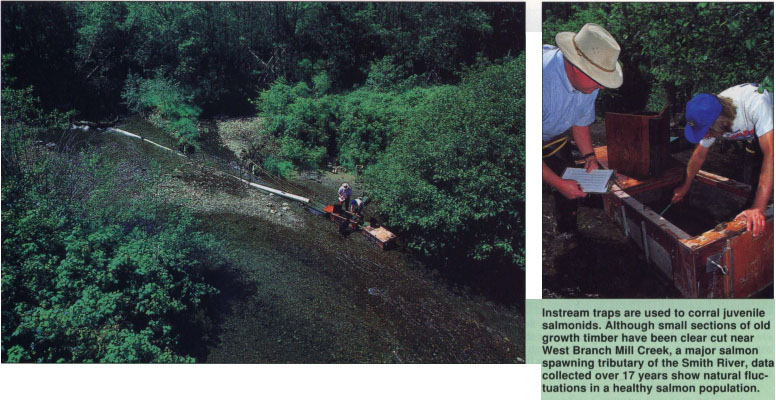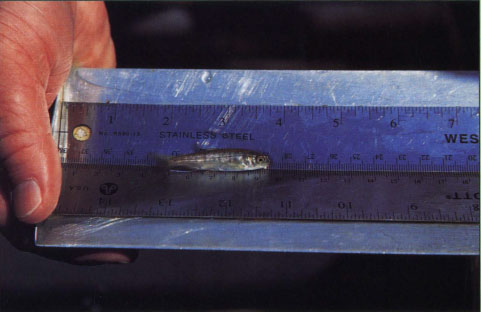All Issues
Salmon restoration depends on improved habitat
Publication Information
California Agriculture 51(4):28-29. https://doi.org/10.3733/ca.v051n04p28
Published July 01, 1997
PDF | Citation | Permissions
Abstract
The streams and rivers that California's salmon and trout call home during the freshwater portion of their life cycle have deteriorated over the past 50 years, resulting in decreases in the populations of these salmonids. Habitat deterioration and population changes are caused by natural occurrences (floods, fires, El Niños, drought, predators and changing ocean conditions); land-use practices (mining, timber harvest, highway construction, agriculture, grazing and urban development); increases in fishing effort; and major diversions of water resources and the damming of rivers.
Full text
Instream traps are used to corral juvenile salmonids. Although small section of old growth timber have been clear cut near West Branch Mill Creek, a major salmon spawning tributary of the Smith River, data collected over 17 years show natural fluctuations in a healthy salmon population.
The streams and rivers that California's salmon and trout call home during the freshwater portion of their life cycle have deteriorated over the past 50 years, resulting in decreases in the populations of these salmonids. Habitat deterioration and population changes are caused by natural occurrences (floods, fires, El Niños, drought, predators and changing ocean conditions); land-use practices (mining, timber harvest, highway construction, agriculture, grazing and urban development); increases in fishing effort; and major diversions of water resources and the damming of rivers.
Restoration of California's salmon and steelhead populations depends on the principle of managing natural stocks. The genetic diversity and population viability of individual runs of salmon requires that watershed and habitat conditions throughout a species range be restored or protected.
Improving degraded habitat, protecting stream quality, providing adequate clean water and flows, reducing fish harvest when appropriate and the long-term monitoring of fish runs are all part of the equation for restoring salmonid populations.
In recent years, the excellent returns of chinook salmon to the Sacramento and Klamath river systems have been direct reflections of improved ocean conditions and hatchery fish production. Natural salmon production, however, continues to decline in most watersheds.
In 1979, when I became Sea Grant Advisor for Del Norte County, the Smith River was in the process of being designated a Wild and Scenic River. The Smith was described as an “excellent” salmon and steelhead stream; however, no evaluation criteria for natural salmonid stocks existed. Because of the need for a good research index stream (a stream that reflects healthy, natural fluctuations in a fish population), I initiated a 20-year chinook salmon spawning escapement study in 1980 on West Branch Mill Creek, a major salmon spawning tributary of the Smith River.
The study section, on private timber land owned by the Rellim Redwood Company, is surrounded by lands that belong to the California State Park and Redwood National Park System. At the inception of the study, the West Branch watershed consisted of old-growth redwoods. Although small sections of old growth were clear cut between 1986 and 1995, the stream habitat has remained largely intact.
The 17 years of data collected on Mill Creek shows natural fluctuations in a healthy salmon population (fig. 1). The data reflect changes in natural environmental conditions (drought and flood) that have allowed the fish to withstand certain habitat changes. The study is also providing valuable information about coexisting coho and chum salmon populations.
Samples of juvenile salmon and steelhead are netted out of the creek and measured to determine growth rates.
Although monitoring adult spawning salmon is a good way to gauge stock health, the real key to the health of salmonid habitat is juvenile salmon (smolt) production. During the past 5 years, Rellim biologists and I have monitored juvenile coho and chinook salmon production and compared it to adult spawning escapement. The results are just beginning to show a system in biological balance that can withstand fluctuations in adult returns and changing environmental conditions.
Restoring salmon habitat and increasing production also require educating landowners, enhancement groups and the public — those who will be responsible for covering the “costs” of improving and restoring salmon resources. In 1983, Northern California Sea Grant advisors organized the first statewide enhancement conference, which functioned as a valuable source of information about technical needs and project funding sources. These conferences continue as a primary information outreach to community-based restoration groups with guidance from the Salmonid Restoration Federation.
Extension Sea Grant staff have also coordinated programs for the Spring-Run Chinook Salmon Workgroup on the Sacramento River. Habitat improvement actions taken by this group of farmers, landowners, fishers, forest managers, irrigation districts, environmentalists and resource agencies have delayed a potential Endangered Species Act (ESA) listing of this stock.
The recent and potential listings of salmon and steelhead species under the Federal ESA have brought home the need for community cooperation in restoring salmonid habitat and healthy stocks. Not only are these resources important to the economic viability of many communities, they are also symbols of our commitment to a healthy environment and biodiversity.
Further reading
Howard C.. Juvenile Salmonid Monitoring on the East/West Branches of Mill Creek. Rellim Redwood Company Technical Report. 1994. 25.
Toole C, Waldvogel J.. Proceedings of the 7th-12th Salmonid Restoration Conferences. UC Cooperative Extension 1989–1994.
Waldvogel J.. Fall Chinook Salmon Spawning Escapement Estimate for a Tributary of the Smith River, California. Second Interim Report (1980–87), UCSGEP-88–5 1988. 22.







